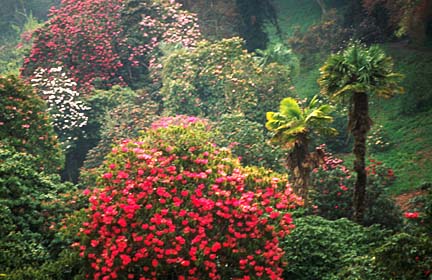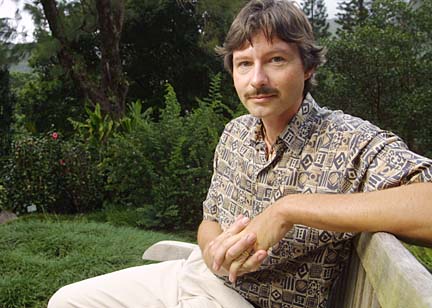


In The Garden![]()
Friday, January 11, 2002

|
AMONG the great gardens of the world, Trebah Garden in England is a true beauty -- the more you come to know it, the more beautiful it becomes. Garden Roots
A lecture at Lyon Arboretum will
discuss how a ship broker's vision
blossomed into reality in EnglandBrushes with gardens of royalty started
expert on search for unusual sitesTrebah Garden, like many gardens in Great Britain built in the 19th century, is filled with non-native plants introduced by British plant hunters who traveled the world for unusual plants. It was the fashion then: Wealthy patrons, looking to distinguish themselves, cultivated good taste by building elaborate gardens populated with rhododendrons, camellias, magnolias, tree ferns and many other specimens collected from the Himalayas, China, Korea, America and other foreign lands.
But Trebah Garden is no run-of-the-mill "plant hunter garden." Its builder, Charles Fox -- ship broker by trade, Quaker by belief, plant lover by nature -- was a man with an enlightened mind and a plan.
"He was very unusual (in that) his vision was not only to obtain an exotic plant collection, but he wanted his garden to be in harmony with its surroundings. The result is a truly unusual and beautiful garden," said Rene Johansen, an expert on the gardens of Europe.

|
Johansen, who has designed and led European garden tours since the 1990s, will reveal the unusual history of Trebah Garden in a lecture at Lyon Arboretum Jan. 19. The lecture, focusing on three outstanding gardens, is the first in a series of slide lectures on European gardens.While he has included other, equally beautiful gardens of Europe in his lectures, Johansen said he picked Trebah Garden for its unusual history and the way it exemplifies good garden design.
"If you understand what Fox did, the history of how he accomplished his long-cherished goals, the more you'll appreciate the garden," Johansen said.
First, Fox selected a 25-acre valley in the duchy of Cornwall that he knew would be the perfect location for his dream garden. Exotic plants normally are too tender to thrive in the cold British climate, but this long and narrow ravine bordering the warm waters of the Gulf Stream was hospitable grounds.
He then established protection from the cold northern winds for his future garden by planting a shelter belt of pine trees around the perimeter. In the 10 to 15 years it took for the pines to mature, Fox educated himself on cultivation of the exotic plants.
"None of these plants have ever been grown in Britain before," Johansen said. "What were their requirements? When did they flower, how big would the flowers get, what colors were there? Nobody really knew the answers."
As a ship broker, Fox had ready access to the plant hunters, and he gathered as much information from them as he could. In 1840, when he was ready to plant his garden, Fox knew what he wanted to do and how to do it.

|
Fox ordered his carpenters to build wood scaffolding towers of varying heights to represent mature trees. Then on a clear and calm morning, with a telescope and megaphone in hand, he climbed onto the roof of his mansion to direct the planting operation.His workers scrambled up and down the steep ravine with the towers -- some as tall as 30 feet -- placing them in desired locations for Fox to envision how the trees would look when fully grown. He wanted to be sure that the mature trees would not conflict with other plantings or interfere with the view to the ocean.
"Without a doubt, the bizarre effort paid off," Johansen said. "The first time I was there, I was just floored. It is unbelievably beautiful. It is how a garden should be laid out."
Fox understood the merits of restraint, Johansen said. He didn't aim to cram in as many plants as possible or as many colors as possible. He wanted a natural-looking garden where plants complement each other. His use of colors, textures and shapes was prudent, never going overboard and always allowing the plants to speak for themselves.
Luckily, succeeding owners remained true to his vision while introducing new species. His son-in-law planted several hundred tree ferns (Dicksonia antarctica) that now stand about 18 feet tall and have become a major attraction at the garden. Fox's plantings, however, remain the backbone of the garden.

|
"The garden only grew more beautiful with age. The plantings matured, and the later plants added to the garden work beautifully with what's already there," Johansen said.World War II interrupted the garden's upkeep, and soon it became a jungle with little bearings to its former glory. Without realizing its history, Tony Hibbert, a retired British major with interest in sailing, purchased the property in 1981 for its access to the ocean.
"He didn't know there was a garden at all until a chap from the Cornwall Garden Society came to him and wanted to know how well he was doing with the restoration of the garden," Johansen said.
Hibbert, not a garden enthusiast, had a dilemma. He could take on the tremendous task of restoring the garden, or sell the property and let it be somebody else's problem.
"Well, the British have been keen plantsmen and gardeners for many centuries; he had no choice, really. And we are lucky because of it; we still get to enjoy it. The garden, part of it, is rated among one of the 80 most beautiful gardens in the world," Johansen said.

|
While most children learn about gardening by playing with dirt in the yard, Rene Johansen developed a keen eye for gardening by visiting stately gardens once owned by European royalty. Brushes with gardens
of royalty started expert
on search for unusual sites"My parents took me to a garden every weekend. From there I really learned to appreciate nature and gardens," said Johansen, a East German native who has traveled the world in search of unusual gardens and nature preserves.
Johansen, whose family emigrated to West Germany before the Berlin Wall fell, has worked as a landscape designer, writer and lecturer. His childhood education in Renaissance, Baroque, English and other styles of European gardens led him to design and lead specialized tours to famous gardens across Europe.
The tours have made him an expert on European gardens, their history and designs and plants, which he will share in a lecture series at Lyon Arboretum in Manoa.
Johansen moved to Hawaii in 1998 after he met and fell in love with a midwife while on an expedition to Molokai. He and his wife, JoAnn, live on Molokai, where he has not yet been able to begin a garden of his own.
Johansen also volunteers at the arboretum by lending his expertise in garden designs. He is drawing plans for a children's garden that will be a hands-on educational learning center with native and Polynesian-introduced plants.
Volunteers to help with clearing the grounds, planting, guiding tours and other chores also are needed. Call Jill Laughlin, 988-0471.
>> "Magical Gardens: The Hidden Story": Introduction to three European gardens that can only be understood by revealing their hidden stories: Trebah Garden in England, Garden of Casa Camuzzi in Switzerland, and Isola Bella in Lago Maggiore in Italy, 10 to 11:30 a.m. Jan. 19.
European gardens backstage
A series of three slide lectures by Rene Johansen
Place: Lyon Arboretum, 3860 Manoa Road
Cost: $8 ($6 members) per lecture; advance registration is required
Call: 988-0456
>> "Growing Pleasure: Cottage Gardens": Cottage gardens in France are not the same as those in Switzerland. Structures, types of plants and other regional traditions are revealed, 10 to 11:30 a.m. Feb. 2.
>> "The Prince as Gardener: The Fairytale Garden of Wörlitz, Germany": The Prince of Saxony-Anhalt was an avid gardener and follower of the philosophy of Enlightenment. See how he combined his two passions in an unusual garden, 10 to 11:30 a.m. Feb. 16.
Gardening Calendar
Suzanne Tswei's gardening column runs Saturdays in Today.
You can write her at the Star-Bulletin,
500 Ala Moana, Suite 7-210, Honolulu, HI, 96813
or email stswei@starbulletin.com